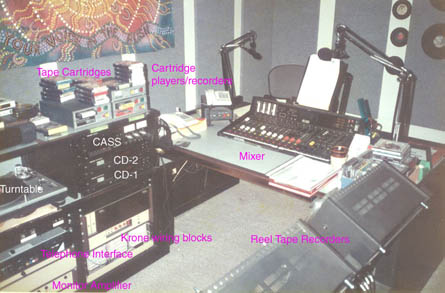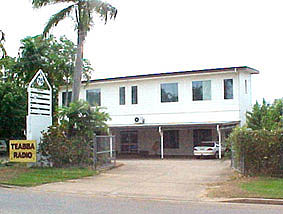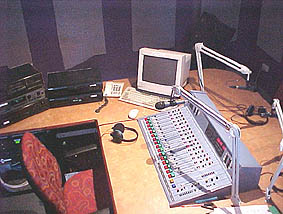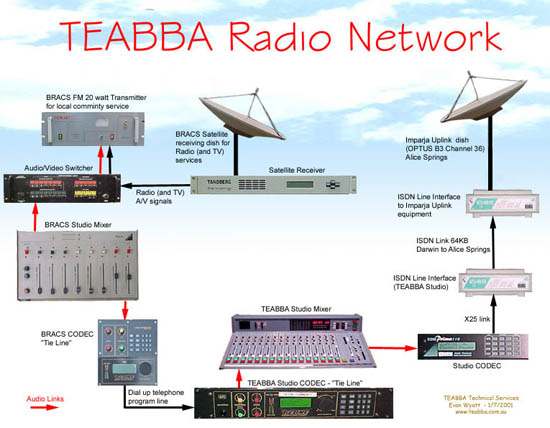|
Establishment
of TEABBA
Following the rapid establishment of BRACS sites in
communities, it was becoming apparent to some members
of Top End communities, that there was a need for the
establishment of a local body to represent the interests
of the community broadcasters. To satisfy this need,
the TEABBA association was formed.
The
inaugural meeting was held at Kakadu in 1989. From that
meeting, a committee and membership was set up with
representation from all the Top End communities. The
new association secured temporary office and studio
space in a building on the Batchelor College campus,
100km south of Darwin.
Radio
Rum Jungle
It was here that TEABBA took on the call sign of Radio
Rum Jungle (after the old uranium mine nearby at
Rum Jungle). The new organisation was funded by a grant
from Aboriginal and Torres Strait Island Commission
(ATSIC) and continues to receive funding from this body.
TEABBA
became the local broadcaster for the Batchelor township
area and also served as a training base for Aboriginal
and Torres Strait Islander students attending the Diploma
in Broadcast and Journalism and the BRACS Certificate
course at Batchelor College.
Studio
equipment was supplied and installed by the ABC for
the use of both Batchelor College and TEABBA and consisted
of a twelve channel stereo broadcast mixer, cartridge
player and recorder, reel tape recorders, turntables,
cassette player/recorders, CD players and a telephone
interface unit for talkback programs.

Studio equipment. Photo: Evan Wyatt.
Courtesy: TEABBA. |
However
time was running out for TEABBA to remain in the building
at Batchelor. Due to expansion at the college, they
were desperate for room and TEABBA was asked to seek
alternative accommodation. This situation forced a decision
by the Board to move the operation to Darwin as it was
felt that it would give organisations better access
to facilities and the services now provided to the communities.
The move was completed in June 1994.

TEABBA
radio, Darwin. Photo: Evan Wyatt. Courtesy:
TEABBA |
|

TEABBA
radio studio. Photo: Evan Wyatt. Courtesy:
TEABBA. |
|
After
the move, TEABBA secured access to a spare mono audio
channel on the Central Australian Aboriginal television
service (IMPARJA) satellite transponder. An Integrated
Services Digital Network (ISDN) semi-permanent link
carries the program from the Darwin studio to IMPARJA.
This connection realised early plans for a radio network,
with a distinctive Top End sound from the bush, as opposed
to the programs broadcast to the communities at that
time by the Central Australian Aboriginal Media Association
(CAAMA).
Satellite
channel
With their own satellite channel, the next step was
to connect the BRACS studios into that network. This
posed a major problem, as Telstra could not provide
circuits in the communities for a 10khz broadcast line,
and if they could, the rental costs would have been
prohibitive.
TEABBA
were left with only one choice for the program line,
use standard dial up telephone lines connected to telephone
interface units at both ends. When a telephone call
was established, the line would be routed through the
TEABBA studio to the IMPARJA satellite transponder for
delivery to communities for re-broadcasting.
TEABBA's
role
TEABBA's program is a mix of news, music and chat in
Aboriginal languages and some English, reaching an Aboriginal
and Torres Strait Islander audience of approximately
17 000 people. It is different from a normal broadcast
station in that it does not have a licensed broadcast
transmitter, that is, it is a retransmission broadcast
hub for the isolated Top End BRACS communication network.

Tony
Binalay, TEABBA radio announcer.
Courtesy: TEABBA
mp2 file 1,601k
TEABBA's
role is a service provider to the community broadcast
stations and to manage the hub that connects either
the Darwin studio or any of these community studios,
into the ISDN program link feeding the IMPARJA satellite
uplink at Alice Springs. The network program is then
delivered by satellite, back to those 28 communities
for rebroadcast on low powered FM transmitters.

TEABBA network. Courtesy: TEABBA
|
TEABBA network unique
The
TEABBA network is unique in that it is an Aboriginal
and Torres Strait Islander radio network hub, its
broadcasters and control is based in the bush, it
has a diversity of language groups, and the program
content must observe cultural protocols at both community
and national level. This TEABBA model has shown the
way for other Aboriginal and Torres Strait Islander
media groups, on how to set up and operate a bush
based radio satellite network.
TEABBA
has an exciting future, with more communities due
to come on to the network, we also see our future
role as a broadcast technical training base and a
training provider for community broadcasters. (Wyatt,
1996)
Activity
Draw a diagram to illustrate the role of TEABBA as manager
of the hub that connects the Darwin or community studios
to Alice Springs into the ISDN program link.
Visit
the Media report link below and scroll down to the section
where Evan Wyatt is interviewed. It will give you a
good idea about why TEABBA is so different.
Media
report
http://www.abc.net.au/rn/talks/8.30/mediarpt/mstories/mr040796.htm
|